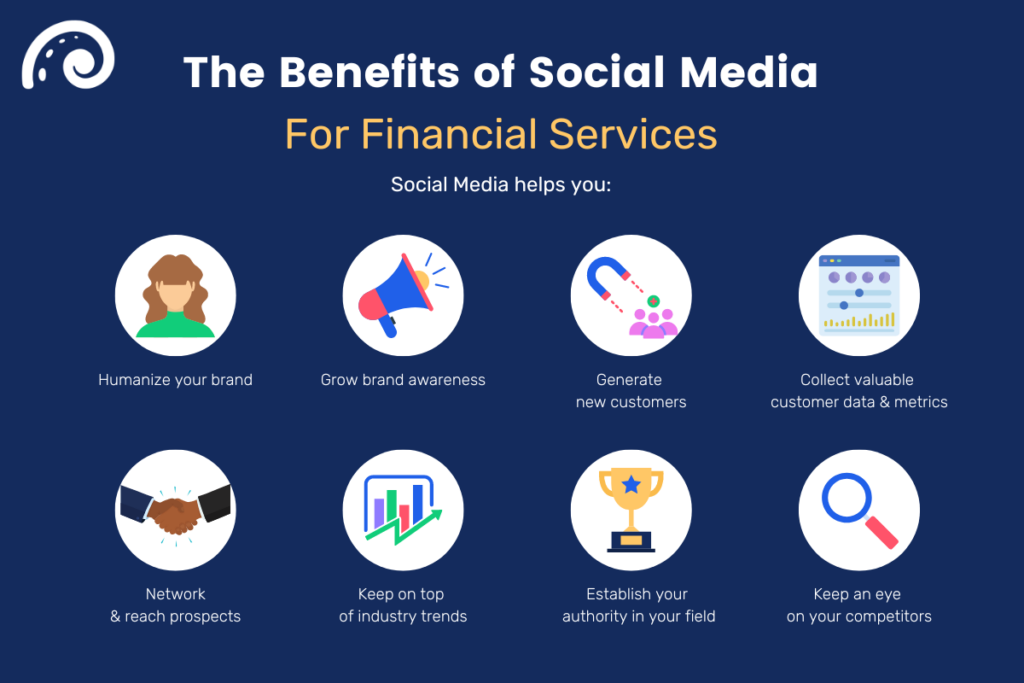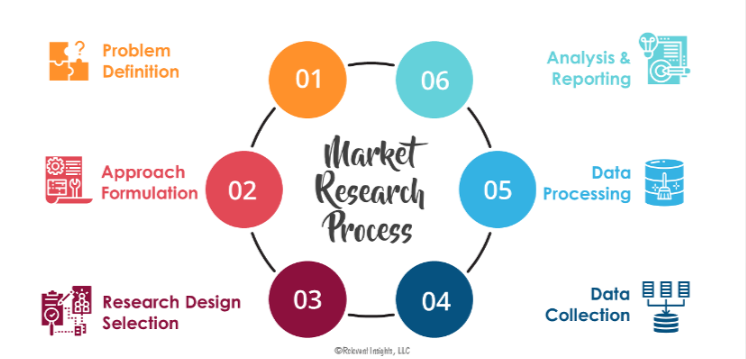Social media started out as a digital haven for personal connections, where friends and family could stay in touch across distances.
Isn’t it amazing how the internet has evolved over the years? It’s no longer just a personal space, but it’s become an essential tool for businesses in all sorts of industries!
In the realm of financial services, this evolution has given rise to a new era of opportunities and challenges.
When it comes to social media, financial institutions need to be careful and strategic in how they manage their presence. Proper management of these platforms is crucial for achieving success.

In this comprehensive post, we delve into the realm of social media management tailored specifically for the delicate world of financial services.
We’ll see how your financial company can leverage social media to foster trust with your customers, deliver value, and navigate the regulations that govern the industry.
We’ll discover the ins and outs of successful social media management in the financial industry, from crafting engaging content to upholding regulatory standards that protect your business’s reputation.
We will walk you through everything you need to know about leveraging social media to boost your financial company’s online presence, brand authority, and customer engagement.
Whether you’re a newbie or an experienced marketer looking to refine your social media strategy, these proven strategies will help you achieve your goals.
- First things first
- Strategy 1: Define Your Social Media Goals and Target Audience
- Strategy 2: Choose the Right Social Media Platforms
- Strategy 3: Create Compelling and Educational Content
- Strategy 4: Engage and Interact with Your Audience
- How Your Business Benefits
- Ways to Engage with Your Audience
- Strategy 5: Measure and Analyze Your Social Media Performance
- What to Measure in Social Media Analytics
- Conclusion: Mastering Social Media Management for Financial Services
First things first
Before we get started with social media, there are certain things we need to clarify.
First off, social media should not be your primary channel to drive traffic to your business.
While social media can be a valuable tool for driving traffic to a finance business, relying solely on it as the primary channel may not always be the most effective approach.
Here are some reasons why:
1. You Have Little or No Control Over the Platform
Social media platforms control the rules and algorithms that determine how your content is shown to users.
Whenever these platforms roll out an update in their algorithms, it can impact your reach and engagement.
It makes it unpredictable and sometimes unreliable as the sole source of traffic.
2. Social Media is Not Always Reliable
We’ve seen several social media platforms come and go (think MySpace, StumbleUpon, and FourSquare).
If a platform goes down or experiences technical issues, all your hard work, including your traffic generation, could come to a halt.
Remember what happened when Facebook went down for several hours last year?
It caused chaos for businesses and users alike.
This shows the importance of not relying solely on social media for your business.
3. Limited Content Types
While social media supports various content formats, it might not be the ideal platform for sharing detailed financial information or complex products/services.
Social media has restrictions about how long a post can be as well as how often to post. Some financial topics require longer-form content and hence will not be suitable for social media.
4. Reach is Limited
Regardless of how many followers you have, social media will not show your posts to all of them.
Facebook, for instance, shows your posts to about 6% of your followers, and an average account or page gets as little as 0.07% engagement, according to a study by Hootsuite.
5. You Can’t Control the Look and Feel of Your Profile
This one is a big one for me. All the Instagram or Twitter profiles are the same for everyone. Nothing unique about them.
They can’t represent your brand as well as a space you own can.
Considering all the downsides of relying solely on social media, it is wise to set up a website for your financial business.
Your website serves as your online storefront or your 24/7 headquarters for your business. Instead of relying on social media, use it to drive traffic to that stunning website you own and control.
That way, you’re sure to capture everyone visiting your website sees what you want them to see. And you can collect contact information from your site visitors so you ‘sell’ to them later.
This cool feature is not available on social media.
As I mentioned moments ago, your social media should rather be one of your strategies to drive traffic to your website, in addition to email marketing, content marketing, and probably influencer marketing.
That said, let’s talk about social media financial services marketing. We’ll discuss five strategies you can utilize to ensure you’re doing social media marketing the right way for your financial business.
Strategy 1: Define Your Social Media Goals and Target Audience
Let me tell you a story.
Once in a bustling village, there lived two skilled archers – Alex and Mia. They both had a deep passion for archery and aimed to become the best in the land.
One day, a wise old mentor visited the village and offered a challenge to both archers. The challenge was to hit as many targets as possible within a fixed time.
Alex, eager to showcase his talent, started shooting arrows swiftly, hitting targets randomly as they appeared.
Mia, on the other hand, took a different approach.
Before the challenge began, she carefully studied the targets, noting their distances, sizes, and patterns.
She set a clear goal to hit a certain number of targets with precision.
As the challenge began, Alex continued shooting hastily, hitting a few targets but missing many. Mia, armed with her goal in mind, aimed meticulously and hit her targets with remarkable accuracy.
When the time was up, Mia had achieved her goal, hitting the exact number of targets she had set out to.
Alex, despite his speed, had fallen short of a specific target count and struggled to showcase consistent performance.
Just like the archers Alex and Mia, you’re aiming to hit targets – your marketing objectives – in the vast landscape of social media.
Alex represents a business without clear goals and objectives.
Without defined goals, your social media finance services efforts might lack direction. You might post content randomly, engaging with users without a clear purpose.
In the same way, when you set clear goals for your financial social media marketing, you’re like Mia.
You’re not just posting content for the sake of it. You’re aiming for specific outcomes, be it increasing brand awareness, driving traffic to your website, generating leads, or building customer trust.
With goals, you have a clear direction. You know what you’re aiming for, and every post, every engagement, is a step towards hitting those goals.
So, just as Mia’s archery skills were magnified by her goal, your financial business can amplify its social media success through well-defined objectives.
Conduct thorough market research to identify your ideal customers, their pain points, interests, and demographics. Use analytics tools provided by social media platforms to gain valuable insights into your audience’s behavior.

For instance, If you’re a financial advisory firm targeting millennials, your content might focus on topics like budgeting, saving for retirement, and investing in cryptocurrencies.
Additionally, you could use Instagram and TikTok to reach this younger audience effectively.
Set specific, measurable targets, and then release your social media content with purpose and direction.
With each well-aimed post, you’ll be one step closer to hitting your desired outcomes and achieving success in the world of social media financial services.
Strategy 2: Choose the Right Social Media Platforms
Choosing the appropriate social media platform is a crucial step in financial social media marketing that requires careful consideration.
Each platform offers unique features, capabilities, and limitations that can impact your reach, engagement, and brand image.
Choosing the right platform ensures that your social media marketing efforts are spent on audiences that’ll do business with you and will align with your goals effectively.
Why Platform Choice Matters
It’s essential to consider your target audience, content strategy, branding, and goals when selecting a platform.
You should also evaluate the platform’s advertising options, analytics, and community management tools to ensure that you can effectively measure and optimize your performance.
Here are some factors to consider;
Audience Relevance
Different platforms attract diverse audiences. Choosing a platform aligned with your target demographic ensures your content reaches those most likely to engage with your financial services.
Content Fit
Each platform favors specific content formats. Some platforms are image-centric, while others encourage longer written content or video.
The right platform enables you to present your financial content in the most engaging manner.
Engagement Style
Audience behavior varies across platforms. Some platforms thrive on discussions and conversations (think Reddit and Twitter), while others focus on quick interactions.
Selecting the most suitable platform enables you to engage in ways that resonate with your audience.
Regulatory Compliance
The financial industry is regulated, and different platforms have varying levels of flexibility when it comes to compliance.
That’s why you must choose a social media platform that aligns with your industry’s regulations.
When you select the right social media platform, you can build a strong online presence, increase your audience, and achieve your business objectives.
That begs the question; which platform will be suitable for social media financial services?
Different Social Media Platforms

Let’s see how each of the most popular social media channels behave, and which one will be more suitable.
With its broad user base, Facebook offers diverse targeting options. It’s suitable for sharing informative articles, financial tips, and educational content. It’s particularly effective for B2C engagement.
Often considered the professional network, LinkedIn is ideal for B2B engagement and establishing thought leadership.
Share insightful articles, industry trends, and network with professionals.
Known for its concise nature, Twitter is suitable for quick updates, sharing financial news, and engaging in real-time conversations.
Ideally, it’s great for sharing bite-sized financial insights.
Instagram, as the logo suggests, is a visually driven platform, and is effective for showcasing visual content like infographics, charts, and behind-the-scenes glimpses.
YouTube
Video content finds its home on YouTube. It’s perfect for hosting educational videos, tutorials, webinars, and explainer videos about complex financial concepts.
TikTok
Emerging as a platform for short, engaging videos, TikTok can be effective for simplifying financial ideas or trends in a creative way, targeting a younger demographic.
Pinterest is similar to Instagram with how it’s heavily about pictures/images.
Suited for visual inspiration and longer-lasting content visibility, Pinterest can be used to share financial planning guides, investment tips, and visually appealing content.
As we’ve seen, all the platforms we’ve mentioned can be used for social media financial services marketing. However, the one you’d choose will depend on who you’re targeting with your financial services.
Young Professionals: Platforms like LinkedIn and Twitter are favored by professionals seeking industry insights and networking opportunities.
Millennials and Gen Z: Instagram, TikTok, and YouTube resonate with younger audiences seeking relatable and visually appealing financial content.
Business Decision-Makers: LinkedIn remains a hub for B2B interactions, catering to business decision-makers and industry professionals.
General Audience: Facebook attracts a wide range of demographics, suitable for sharing general financial advice and updates.
To be on the safer side, I’ll say choose Linkedin as your main social channel.
LinkedIn is a social media platform that often aligns well with the regulations of the financial industry.
This platform is specially designed for professionals, businesses, and industry experts, making it a suitable space for financial institutions to share insights, thought leadership, and industry-related updates.
On linkedin, your posts wouldn’t compete with viral videos and funny memes. Hence, you’re sure to reach a more ‘mentally primed for business’ kind of people.
In conclusion, the right platform choice is pivotal for successful financial social media marketing. Consider your audience, content type, engagement style, and regulatory requirements when making your decision. A well-informed platform selection enhances your ability to connect with the right audience, deliver your financial message effectively, and achieve your marketing goals.
Each social media platform caters to different demographics and has its unique features.
Choose platforms that align with your target audience and business objectives. Here’s a quick overview:
Facebook: A versatile platform with a wide age range and diverse audience. Ideal for brand awareness, community-building, and targeted advertising.
Twitter: Great for real-time updates, industry news, and customer service interactions.
LinkedIn: Primarily for B2B networking, thought leadership, and lead generation in the financial services industry.
Instagram: Visual platform suited for storytelling, showcasing products, and reaching younger audiences.
YouTube: Perfect for sharing educational and informative videos, building credibility, and increasing engagement.
It’s essential to maintain a consistent presence on the platforms you choose, as a lack of activity may harm your brand’s credibility.
Crafting Platform-Specific Content
Each platform requires tailored content formats. For example:
Facebook and LinkedIn: Share insightful articles, blog posts, and industry news. Utilize visual elements like infographics to convey complex financial concepts.
Twitter: Engage with followers through concise and engaging tweets. Use relevant hashtags to increase visibility.
Instagram: Post visually appealing images and stories related to finance and investments. Leverage Instagram reels for short, informative videos.
YouTube: Create in-depth video tutorials and explainer videos. Optimize your video titles and descriptions for searchability.
Remember, consistency in branding and messaging across platforms is essential for building a strong brand identity.
Strategy 3: Create Compelling and Educational Content
You know, people’s attention span is limited these days. Capturing the attention of your audience on social media can be quite a challenge, especially if you’re talking about finance of all topics.
However, with the right strategies, you can create compelling content that not only engages your audience but also adds value to their financial journey.
What Makes Content Compelling
Compelling content is like a magnetic force that draws your audience in, making them stop scrolling and pay attention.
It’s content that resonates on a personal level, evokes emotions, and sparks interest.
When it comes to the finance industry, compelling content educates, entertains, or inspires your audience, while also aligning with your brand’s voice and values.
Attention is Everything
With the abundance of content on social media, you have mere seconds to capture someone’s attention.
Compelling content grabs their focus and encourages them to stay and explore further.
Building Trust
Finance involves sensitive matters, and people are more likely to engage with content that comes from a trustworthy and relatable source.
When you constantly post content that’s relevant and compelling, it helps build trust with your customers over time.
Encouraging Action
Whether it’s clicking a link, sharing your post, or signing up for your newsletter, compelling content motivates your audience to take action, and hence foster a stronger connection with your audience.
Makes You Stand Out
In a sea of financial advice and ads, your compelling content sets you apart from the competition. It showcases your unique perspective and makes your brand memorable.
Features of a Relevant Content
For content to be relevant to your audience, the content has to
Be Useful
Understand your target audience’s needs, aspirations, and pain points. Craft content that addresses these concerns and offers solutions or insights. That’s what makes your content useful
Tell Stories
Weave narratives (and real-life stories)that resonate emotionally. Share success stories, lessons learned, or challenges overcome to connect with your audience on a personal level.
Look Attractive
Utilize eye-catching visuals – images, videos, infographics – to enhance your content’s look and feel. You can use a well-designed visual to convey complex financial concepts in an easily digestible manner.
Be Clear
Keep your content concise and straightforward. Avoid jargon and complex language that might confuse your audience. Remember, you’re here to simplify finance, not complicate it further.
Vary
Mix up your content formats to keep things fresh. Share tips, industry news, behind-the-scenes glimpses, and interactive polls or quizzes to engage different preferences.
You can even share funny videos or memes relating to finance. Your audience will absolutely love it.
Be Consistent
Develop a consistent posting schedule. Regular updates keep your audience engaged and anticipate your next valuable piece of content.
Have Engaging Calls to Action
Every compelling piece of content should have a clear CTA – whether it’s asking a question, inviting comments, or directing them to your website for more information. If you tell your audience exactly what to do after reading your post, you make it easier for them to interact with you in a way.
Remember, behind every financial decision are real people seeking guidance. Craft your content with care, and watch your financial company thrive in the digital landscape.
Strategy 4: Engage and Interact with Your Audience
Let me guess…
You’re wondering what engaging with audience on social media has to do with finance, where numbers and decisions rule?
Let’s delve into the art of audience engagement, its benefits for both your finance company and your clients, and explore creative ways to keep the conversation flowing.
Engaging with your audience on social media means more than just posting content. It’s about sparking conversations, listening to their feedback, and building a two-way relationship.
It’s a digital handshake that turns casual followers into loyal advocates.
How Your Business Benefits
Engaging with your audience on social media is akin to fostering a genuine conversation with friends.
It builds trust
Replying quickly to comments, messages, and discussions can make your brand seem more friendly and approachable.
By joining in on conversations, addressing concerns, and sharing your knowledge, you can create a welcoming environment and show that your brand is reliable.
Sharing stories and information can help people understand your brand better, and thanking loyal customers or giving them special offers can help build a strong community.
Consistency is key, especially if you’re doing social media financial services marketing.
By being consistent on social media and paying attention to your audience’s needs, you can build trust and show that you care about your customers.
Enhancing Brand Loyalty
Consistently showing up on social media is like keeping the friendship alive – it says, “We’re here for you whenever you need us.”
Ultimately, these interactions transform financial transactions into trusted connections, making loyal customers feel like they’re part of an insightful and caring financial family.
Engaging content keeps your audience coming back for more. The more they engage with your content, the stronger their loyalty becomes, translating into long-term relationships.
Gaining Insights
Actively engaging with customers on social media serves as a goldmine of information.
It opens a window into a world of valuable insights for financial businesses. These interactions provide a direct line to customer sentiments and opinions.
By listening to feedback, you can identify pain points, preferences, and areas of improvement. This customer-centric approach helps you tailor your services and products to meet client needs better.
Social media engagement can uncover trends and emerging topics within the financial landscape.
When you participate in discussions and monitoring conversations, you can stay ahead of market shifts and adapt your strategies accordingly.
Furthermore, direct interactions with customers offer a real-time glimpse into the effectiveness of whatever you’re offerings.
Whether it’s feedback on a new financial tool or questions about a particular service, these engagements provide instant feedback that aids in fine-tuning their offerings.
Beyond that, analyzing engagement metrics like likes, shares, and comments can gauge the popularity of certain content or initiatives.
By discerning which posts resonate most with your audience, you can refine your content strategy for maximum impact.
To benefit fully from these insights, financial businesses can use data analysis tools to track and interpret patterns in customer interactions.
This data-driven approach allows you to make informed decisions, develop customer-centric strategies, and continuously refine your products and services.
By listening to your audience’s feedback and preferences, you can refine your services, create content that resonates, and adapt to changing financial trends.
Amplifying Reach
When a financial company engages with its audience on social media, it’s like casting a wider net to catch the attention of both existing and potential clients.
Through these interactions, their reach gets a turbo boost in several ways.
Each like, comment, and share is like a ripple effect. When the company responds to a customer’s query or acknowledges their feedback, it creates a positive impression.
This often leads to the customer sharing the interaction with their own network, essentially extending the company’s reach to an entirely new audience.
Also, engaging content tends to get shared more.
When you post informative articles, helpful tips, or even entertaining financial insights, it’s likely to be shared by your audience.
This sharing introduces your company to new circles of people who might not have been aware of their services before.
Moreover, responding to comments and messages promptly shows that the company is active and attentive on social media. Hence, encourage more people to engage with your content, and it also boosts the visibility of your posts in others’ feeds due to the algorithms used by social platforms.
Collaborations and partnerships can flourish through social media engagement.
When the company interacts with influencers, partners, or other businesses, it exposes its content to its followers as well, exponentially expanding its reach.
Actively participating in discussions, using relevant hashtags, and even running social media contests can help you tap into trending conversations and get noticed by a broader online audience.
Every interaction can potentially reach not just the initial recipient but also their entire network.
This ripple effect, combined with engaging content and active participation, significantly amplifies the company’s reach, making it visible to a broader and more diverse audience.
Aside your business benefiting when you engage with your audience, your engagement also has a positive impact on your audience.
Your engagement educates, empowers, and builds a community among your customers. In these communities, they can have meaningful conversations that’ll build each other up.
Ways to Engage with Your Audience
Here are some practical ways you can engage with your audience on social media:
Educational Content: Share informative posts, articles, and infographics that explain financial concepts, investment tips, budgeting advice, and more. This positions your company as a helpful resource and encourages engagement through comments and shares.
Q&A Sessions: Host live Q&A sessions where experts from your company answer questions from the audience in real time. You could host a live webinar on tax-saving strategies at the end of the financial year, guiding clients through the latest tax regulations.
This fosters direct interaction and builds trust by addressing concerns directly.
Polls and Surveys: Create polls and surveys to gather opinions on financial topics or to understand your audience’s preferences. People love to share their views, and this interaction generates valuable insights.
Contests and Giveaways: Organize contests or giveaways that require participants to engage with your content. This can boost engagement, increase your following, and create excitement around your brand. Capital One runs social media contests, allowing participants to win gift cards or discounts on their financial products. You can do similar with your finance company, offering something your audience will thoroughly enjoy.
Customer Stories: Share success stories or testimonials from satisfied clients. This not only highlights your company’s impact but also showcases real people who have benefited from your services.
Behind-the-Scenes: Give followers a sneak peek into your company culture, team members, and daily operations. This humanizes your brand and creates a connection beyond financial services.
Trending Topics: Participate in trending conversations related to finance or current events. Using relevant hashtags and sharing your company’s insights shows that you’re up-to-date and engaged with industry trends.
Interactive Content: Post interactive content like quizzes, puzzles, or financial challenges. This encourages participation, shares, and keeps your audience engaged.
Video Content: People are more drawn to videos than to text and images. Share videos discussing financial tips, industry updates, or how-to guides. Video content tends to be engaging and shareable.
Respond to Comments: Always respond to comments, whether they’re questions, feedback, or just expressions of interest.
This creates a two-way dialogue and encourages more interaction. Chase Bank is known for its responsive customer service on Twitter, quickly resolving customer inquiries and issues.
Partnerships and Collaborations: Another way to engage with your audience in social media financial services is to partner with influencers, experts, or other businesses for joint live sessions, interviews, or discussions. This can introduce your brand to new audiences.
Personal Stories: Share personal anecdotes from team members about their financial experiences or lessons learned. This adds a relatable and human touch to your content.
Customer Spotlights: Feature individual customers, their financial journeys, and how your company has helped them achieve their goals.
Themed Campaigns: Run themed campaigns, like “Financial Wellness Month,” where you share relevant content and tips throughout the month to engage your audience.
Strategy 5: Measure and Analyze Your Social Media Performance
If you ask me, I’ll say this point is the most important among the five strategies. You can create the most compelling content ever, or use the most suitable platform.
But in the end, the data will tell you what’s working and what isn’t, and how to tweak your social media strategy.
Why Measure Social Media Analytics for Financial Services
These days, measuring social media analytics isn’t just a trend or a fancy nice-have. It’s a strategic move. Here’s why:
Understanding Audience
Imagine you’re a financial services provider aiming to offer investment advice. By analyzing your social media data, you can discover if your audience is more interested in retirement planning, stocks, or real estate investments.
This insight helps you create content that resonates and build a more engaged community.
Evaluating Performance
Let’s say you’re posting informative articles about tax strategies. Analytics reveal that these articles receive the most shares and comments.
This tells you that your audience values this content, allowing you to refine your content strategy to include more tax-related topics.
Enhancing Engagement
Suppose your financial company shares a video explaining the basics of budgeting. If this video receives a higher-than-average number of likes, shares, and comments, it’s a sign that your audience finds this content helpful and engaging.
You can then focus on creating more educational videos to maintain this engagement level.
Staying Competitive
In finance, trends change rapidly. Measuring social media analytics helps you keep a finger on the pulse of industry conversations.
For instance, you might notice that discussions around cryptocurrency are gaining traction. Armed with this information, you can tailor your content to address these trending topics and stay relevant.
What to Measure in Social Media Analytics

When it comes to metrics, consider these aspects to gain a holistic view of your social media performance:
Reach and Impressions: Think of these as the footprints your content leaves. “Reach” indicates how many unique users see your posts, while “impressions” represent the total times your content is viewed. If a single user sees a post three times, that counts as one reach and three impressions.
Engagement: This metric measures how users interact with your content. If your post about retirement planning receives numerous likes, shares, and comments, it’s a sign that the content resonates with your audience.
Click-Through Rate (CTR): CTR measures the effectiveness of your call-to-action. If you share a post about a new financial tool and include a link for users to learn more, CTR indicates how many users actually clicked that link.
Conversion Rate: This metric reveals how well your social media efforts translate into actual customers. If a post about a limited-time offer generates a spike in sign-ups, that’s a high conversion rate.
Follower Growth: Your follower count reflects your brand’s online presence. If your follower count steadily increases, it indicates that your content is resonating with new audiences.
Top Performing Content: Suppose you find that videos explaining complex financial concepts receive significantly higher engagement than text-based posts. This insight guides you to create more video content to maintain high engagement levels.
Demographics: Understanding your audience’s age, gender, location, and interests is like having a treasure map. If you discover that a significant portion of your audience is interested in retirement planning, you can create tailored content for this demographic.
How to measure social media analytics
Several tools simplify the process of measuring social media analytics:
Google Analytics: Imagine this as a magnifying glass for your website’s traffic. It tells you how many visitors come from social media platforms, giving you insights into the effectiveness of your social media efforts.
Hootsuite: Consider Hootsuite as your command center. It allows you to manage and analyze multiple social media accounts from one dashboard. You can track engagement, follower growth, and more in a user-friendly interface.
Buffer: Buffer is like a scheduling wizard. It lets you plan and schedule posts while also providing insights into how each post performs.
Sprout Social: Think of Sprout Social as an all-in-one solution. It offers a comprehensive suite of social media management tools, including analytics that delve into engagement, audience demographics, and more.
Among these tools, Hootsuite shines as a recommended choice for financial services (that’s my recommendation).
Its user-friendly interface makes it suitable for those who might not be tech-savvy. The analytics are straightforward, giving you a clear understanding of your social media performance without overwhelming you with jargon.
By providing a well-rounded view of key metrics, it empowers you to make informed decisions and optimize your social media strategies effectively.
Conclusion: Mastering Social Media Management for Financial Services
Congratulations! You’ve now gained comprehensive insights into harnessing the power of social media for financial services.
When you set clear goals, understand your audience, choose the right platforms, create compelling content, engage with your followers,
Remember, social media is a dynamic landscape, so continuously monitor your performance, adapt your strategies, and stay up-to-date with the latest trends to maintain a competitive edge in the financial services industry.
We’re also here to help you along the way. At Flying V Group, we’ve worked with several finance companies and handled their social media.
If you need ads, social media management, or you want to reach a specific goal with social media, simply reach out to us.
We’ll do whatever we can to help you. Happy social media marketing.






0 Comments